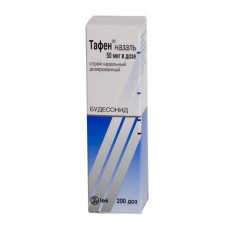Expiration date: 04/2026
Release form and composition:
Metered-dose nasal spray as a white or almost white homogeneous suspension.
1 dose contains:
budesonide 50 µg
Excipients: methyl parahydroxybenzoate, parahydroxybenzoate, microcrystalline cellulose/sodium carboxymethylcellulose, Polysorbate 80, simethicone emulsion, propylene glycol, sucrose, disodium salt of EDTA, hydrochloric acid, purified water.
200 doses of - vials dark glass (1) with a mechanical metering device, with a nozzle for the nose and tip - packs of cardboard.
Pharmacological action:
Corticosteroids for intranasal use. Has a pronounced anti-inflammatory and antiallergic action. When used in therapeutic doses, has practically no resorptive action. Has no mineralocorticoid activity, is well tolerated in long-term care. The drug has an inhibitory effect on the release of mediators of the inflammatory response, increased synthesis of anti-inflammatory proteins, reduces the number of fat cells and eosinophilic granulocytes. Budesonide reduces the release of toxic proteins from eosinophils, free radicals from macrophages and lymphokines from lymphocytes. It also reduces the binding of adhesion molecules with endothelial cells, thus reducing the influx of leukocytes to the site of allergic inflammation. Budesonide increases the number of beta-adrenergic receptors of smooth muscles. The drug inhibits the activity of phospholipase 2A, which leads to inhibition of the synthesis of prostaglandins, leukotrienes and PAF, induce inflammatory response. Budesonide also inhibits the synthesis of histamine, which leads to decrease in its level in fat cells.
Tafen® nasal reduces the severity of symptoms in allergic rhinitis, suppresses the early and late phase allergic reactions and reduces inflammation in the upper respiratory tract. Improvement noted at 2-3 days after initiation of treatment.
Pharmacokinetics:
Suction
After inhalation of budesonide 400 ág Cmax in plasma is reached within 0.7 h and is 1 nmol/L.
Only about 20% of the intranasally administered dose reaches the systemic circulation.
Distribution
Due to its good tissue distribution and plasma protein binding Vd is 301 L.
Metabolism
Systemic bioavailability of budesonide is low, since more than 90% absorbirowawrzayasa of the drug is inactivated in the single-stage process of metabolism in the liver. Glucocorticoid activity of metabolites does not exceed 1%.
Excretion
Metabolites are excreted mainly with urine (70%) and feces. T1/2 is 2-3 h.
Indications:
— prevention and treatment of seasonal and perennial allergic rhinitis
— non-allergic rhinitis
— polypus of the nose.
Dosing regimen:
Adults and children older than 6 years at the beginning of therapy appoint 2 doses (50 mcg of budesonide) in each nostril 2 times/day. The usual maintenance dose is 1 dose in each nostril 2 times/day or 2 doses in each nostril 1 time/day, in the morning. The maintenance dose should be the lowest effective dose that relieves the symptoms of rhinitis.
The maximum single dose is 200 mcg (100 mcg in each nostril), the maximum daily dose - 400 mcg for no more than 3 months.
For a full therapeutic effect requires regular and correct application.
If a dose is missed, it should be taken as soon as possible but not less than 1 hour before taking another dose.
Side effects:
The respiratory system: irritation of the mucous membrane of the nose and throat, epistaxis, cough less marked dryness of the nasal mucosa, sneezing.
Dermatological reactions: marked dermatitis, urticaria, rash.
Other: fatigue, dizziness.
In exceptional cases, the use of nasal corticosteroids was noted nasal septum perforation, angioedema, loss of smell, tachycardia, growth retardation.
In applying the drug side effects develop rarely and are transient in nature.
Contraindications:
— fungal, bacterial and viral infections of the respiratory tract
— active form of pulmonary tuberculosis
— hypersensitivity to budesonide or any component of the drug.
Pregnancy and lactation:
The use of the drug Tafen® nasal during pregnancy may take place only if the expected benefit to the mother outweighs the potential risk to the fetus.
If necessary, the appointment of the drug during lactation breastfeeding should be discontinued.
Special instructions:
In the transition from treatment of systemic corticosteroids for the treatment of nasal spray, in connection with the risk of developing adrenal insufficiency, caution is required for the period of restoration of function of the hypothalamic-pituitary-adrenal axis.
Because corticosteroids slow wound healing, care should be taken when assigning Tafen® nasal patients who recently had an injury or surgery of the nose.
For full therapeutic effect in allergic rhinitis need to take the pills.
It is recommended to avoid contact with eyes.
Effects on ability to drive vehicles and management mechanisms
Tafen® nasal has no effect on the ability to drive or mechanisms.
Overdose:
Accidental overdose of the drug Tafen® nasal does not cause any obvious symptoms. Acute overdose is unlikely.
With prolonged use of high doses and while taking other corticosteroids can appear symptoms of hypercortisolism.
In this case, the drug should be discontinued, gradually reducing the dose.
Drug interactions:
The simultaneous use of the drug Tafen® nasal with inducers of microsomal oxidation (phenobarbital, phenytoin, rifampicin) may reduce the effectiveness of the first.
Methandrostenolone, estrogens, ketoconazole enhance the effect of budesonide.
Terms and conditions of storage:
The drug should be stored out of reach of children at temperature not exceeding 25°C. shelf Life – 2 years.


